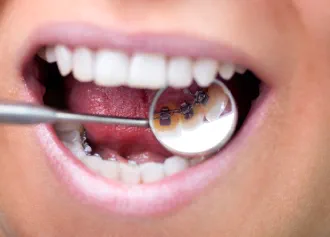Fixed braces
About fixed braces
Also known as train track braces, fixed braces are one of the most popular teeth straightening choices, due to their predictable and reliable results. They’re often used in NHS orthodontics but are also available privately, for all ages. Different types are available, including traditional metal braces and more discreet options, such as lingual and ceramic braces.
Many Bupa Dental Care practices offer a range of fixed braces options. For more information, contact your nearest dentist offering orthodontics. They can answer any questions or help you book an orthodontics consultation.
What are fixed braces?
Fixed braces are made up of small brackets attached to each of your teeth and joined by a wire. Thicker wires are placed and adjusted overtime, creating a gentle pressure which gradually aligns your teeth.
Fixed braces cannot be removed for the duration of your treatment.
Interested in teeth straightening?
To find out more, or to book an orthodontics consultation, contact your nearest practice.
What are the benefits of fixed braces?
- Fixed braces can treat a range of severities. This includes complex orthodontic problems such as extensive overcrowding, abnormal eruption of teeth and a very deep overbite. As a result, fixed braces are often recommended in severe cases.
- Fixed braces offer predictable results. They move your teeth in a precise manner and unlike removable braces, treatment can’t be interrupted by taking them out for long periods
- Some fixed options are very discreet, so people won’t necessarily know you have them.
What are the different types of fixed brace?
There are different types of fixed braces, for a range of needs and lifestyles.
Traditional metal braces
Traditional braces have metal brackets that are attached to the front of your teeth and connected by a metal wire.
The most common orthodontic treatment, traditional braces are used in NHS orthodontics and are a popular private option.

Lingual braces
Lingual braces use metal brackets and wires, just like traditional braces, but they’re attached to the inside of your teeth. This means they’re hidden from view.
If you play contact sports or a wind instrument, lingual braces can be an effective option.

Clear, ceramic braces
Clear braces use the same technique as traditional metal ones, but they’re less visible. They’re made up of ceramic, clear brackets and a thin wire. The wire is typically metal but can be plastic-coated, making the braces even more discreet.

How do fixed braces work?
The wire that connects the brackets creates tension, which gradually shifts your teeth to the final position.
Every four to ten weeks, your dentist or orthodontist will check and adjust your brace. This includes tightening and changing the wires to keep moving your teeth in the right direction.
Depending on your needs, elastic bands or coil springs may be used during your treatment. Elastic bands can improve bite problems and coil strings can close gaps or increase space between teeth.
How much do fixed braces cost in the UK?
The cost of orthodontic treatment depends on the severity of your case and type of brace you have. Ceramic and lingual braces cost more than traditional ones but offer a more discreet option. For an accurate quote, book an orthodontic consultation with your local Bupa practice.
Under 18's may be eligible for free NHS treatment which typically uses traditional, metal braces. Children would need to be referred by their dentist, to an orthodontist specialist, who would assess their eligibility. If they don't qualify for NHS care, private treatment is available.
How long do fixed braces take to work?
The length of your treatment depends on your clinical needs and which teeth need moving.
Cosmetic teeth straightening focuses on the front, visible teeth only. This simple alignment can be completed within just a few months, in some cases. In comprehensive orthodontic treatment, the process can take up to a few years.
Following your consultation your dentist will go through your bespoke treatment plan, including your estimated treatment duration.
What’s the alternative to train track braces?
The alternative to fixed braces is removable braces, which can be taken out for eating, brushing, sport and playing instruments. Different types are available, including transparent, removable aligners, such as Invisalign aligners, and metal, removable braces, such as Inman aligners.
While fixed braces can treat complex cases, removable braces can only fix mild to moderate misalignment, crowding and bite concerns. In your consultation, your dentist or orthodontist will assess your smile to advise the best options for you.
More about orthodontic treatment and aftercare
Clear, ceramic braces
Learn more about clear fixed braces, including what they’re made of, their benefits, and how they compare to traditional braces.
Clear, removable aligners
Clear, removable aligners are a popular option. They’re thin, flexible and completely transparent, so people won’t notice you’re wearing them.
What to expect
Find out the stages involved in getting braces and what happens during an orthodontic consultation.
Braces for children and teens
Learn more about brace options for children.
Caring for your brace
From eating and drinking with braces, to managing discomfort, find out how to best care for your brace.
Teeth whitening after braces
After orthodontic treatment, some patients choose professional whitening, to brighten their new smile safely and effectively.
^ We may record or monitor our calls.
Bupa Dental Care is a trading name of Oasis Dental Care Limited. Registered in England and Wales No: 00478127. Registered office: Bupa Dental Care, Vantage Office Park, Old Gloucester Road, Hambrook, Bristol, United Kingdom BS16 1GW.
Oasis Dental Care Limited has a number of trading names including Bupa Dental Care. For a list of all our different trading names please follow this link.


